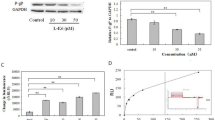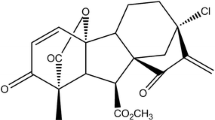Abstract
Purpose
To select P-glycoprotein (P-gp) inhibitor from natural source for reversal of DOX resistance in K562 cells and to develop selected one in to nanoformulation in combination with DOX.
Methods
DOX resistant K562 (K562R) cells were developed and reversal of resistance by P-gp inhibitor was validated by co-treatment with verapamil. The p-gp inhibitors were evaluated for their potential to inhibit P-gp (calcein assay) and to reverse drug resistance (XTT cell viability assay). The selected agent, curcumin was formulated in to liposome along with DOX and characterized for size, zeta potential, encapsulation efficiency and release rate. Uptake, P-gp inhibition and reversal of acquired drug resistance in K562R cells were performed.
Results
P-gp inhibitors such as biochanin-A and curcumin were marked suitable for combination with DOX. However, only curcumin could increase the sensitivity of DOX at all dosing levels, therefore used for further studies. Liposomes loaded with curcumin were formulated and characterized where a prolonged release was observed. The uptake of liposomal curcumin was comparable to nanodispersed curcumin but had lower cytotoxicity. DOX and curcumin coloaded liposomes successfully reversed DOX resistance in K562 cells. Conclusion: The coloaded liposomes increased the safety of curcumin with improved efficacy thus can be employed for reversal of acquired DOX resistance.







Similar content being viewed by others
Abbreviations
- CAN:
-
Acetonitrile
- BioA:
-
Biochanin A
- Cur:
-
Curcumin
- Daid:
-
Daidzein
- DHF:
-
Dihydrofisetin
- DMSO:
-
Dimethyl sulphoxide
- DOX:
-
Doxorubicin
- DSPE-PEG:
-
1,2-distearoyl-sn-glycero-3-phosphoethanolamine-N-[maleimide(polyethylene glycol)]
- EE:
-
Encapsulation efficiency
- HSPC:
-
Hydrogenated soy phosphatidyl choline
- MFI:
-
Mean fluorescent intensities
- OPA:
-
Ortho-phosphoric acid
- PFA:
-
Paraformal dehyde
- P-gp:
-
P-glycoprotein
- EPR:
-
Enhanced permeation and retention
- Gen:
-
Genistein
- mPEG:
-
Methoxy polyethyleneglycol
- PCL:
-
Poly-ε- caprolactone
- Resv:
-
Resveratrol
- Sily:
-
Silymarin
References
Golan DE. Principles of pharmacology: the pathophysiologic basis of drug therapy. Wolters Kluwer Health/Lippincott Williams & Wilkins; 2008.
Dudhatra GB, Mody SK, Awale MM, Patel HB, Modi CM, Kumar A, et al. A comprehensive review on Pharmacotherapeutics of herbal Bioenhancers. Sci World J. 2012;637953:1–33.
Yardley DA. Drug resistance and the role of combination chemotherapy in improving patient outcomes. Intern J Breast Cancer. 2013;137414:1–15.
Komarova NL, Boland CR. Cancer: calculated treatment. Nature. 2013;499(7458):291–2.
Konig J, Muller F, Fromm MF. Transporters and drug-drug interactions: important determinants of drug disposition and effects. Pharmacol Rev. 2013;65(3):944–66.
Varma MV, Ashokraj Y, Dey CS, Panchagnula R. P-glycoprotein inhibitors and their screening: a perspective from bioavailability enhancement. Pharmacol Res. 2003;48(4):347–59.
Abdallah HM, Al-Abd AM, El-Dine RS, El-Halawany AM. P-glycoprotein inhibitors of natural origin as potential tumor chemo-sensitizers: a review. J Adv Res. 2015;6(1):45–62.
Giacomini KM, Huang SM, Tweedie DJ, Benet LZ, Brouwer KL, Chu X, et al. Membrane transporters in drug development. Nat Rev Drug Discov. 2010;9(3):215–36.
Watkins R, Wu L, Zhang C, Davis RM, Xu B. Natural product-based nanomedicine: recent advances and issues. Int J Nanomedicine. 2015;10:6055–74.
Bharali DJ, Siddiqui IA, Adhami VM, Chamcheu JC, Aldahmash AM, Mukhtar H, et al. Nanoparticle delivery of natural products in the prevention and treatment of cancers: current status and future prospects. Cancer. 2011;3(4):4024–45.
Sinha R, Kim GJ, Nie S, Shin DM. Nanotechnology in cancer therapeutics: bioconjugated nanoparticles for drug delivery. Mol Cancer Ther. 2006;5(8):1909–17.
Shapira A, Livney YD, Broxterman HJ, Assaraf YG. Nanomedicine for targeted cancer therapy: towards the overcoming of drug resistance. Drug Resist Updat. 2011;14(3):150–63.
Dash TK, Konkimalla VB. Formulation and optimization of doxorubicin and biochanin a combinational liposomes for reversal of chemoresistance. AAPS PharmSciTech. 2017;18(4):1116–24.
Hu C-MJ, Zhang L. Nanoparticle-based combination therapy toward overcoming drug resistance in cancer. Biochem Pharmacol. 2012;83(8):1104–11.
Fan Y, Zhang Q. Development of liposomal formulations: from concept to clinical investigations. Asian J Pharm Sci. 2013;8(2):81–7.
Dash TK, Konkimalla VB. Comparative study of different nano-formulations of curcumin for reversal of doxorubicin resistance in K562R cells. Pharm Res. 2017;34(2):279–89.
Kathawate L, Joshi PV, Dash TK, Pal S, Nikalje M, Weyhermller T, et al. Reaction between lawsone and aminophenol derivatives: synthesis, characterization, molecular structures and antiproliferative activity. J Mol Struct. 2014;1075:397–405.
Abraham SA, Waterhouse DN, Mayer LD, Cullis PR, Madden TD, Bally MB. The liposomal formulation of doxorubicin. Methods Enzymol. 2005;391:71–97.
Lichtenberg D, Barenholz Y. Liposomes: Preparation, characterization, and preservation. Methods of Biochemical Analysis: John Wiley & Sons, Inc.; 2006. p. 337–462.
Sun D, Zhuang X, Xiang X, Liu Y, Zhang S, Liu C, et al. A novel nanoparticle drug delivery system: the anti-inflammatory activity of curcumin is enhanced when encapsulated in exosomes. Mol Ther. 2010;18(9):1606–14.
Kang L, Gao Z, Huang W, Jin M, Wang Q. Nanocarrier-mediated co-delivery of chemotherapeutic drugs and gene agents for cancer treatment. Acta Pharm Sin B. 2015;5(3):169–75.
Ma L, Kohli M, Smith A. Nanoparticles for combination drug therapy. ACS Nano. 2013;7(11):9518–25.
Wu CP, Ohnuma S, Ambudkar SV. Discovering natural product modulators to overcome multidrug resistance in cancer chemotherapy. Curr Pharm Biotechnol. 2011;12(4):609–20.
Srivalli KMR, Lakshmi PK. Overview of P-glycoprotein inhibitors: a rational outlook. Brazilian J Pharm Sci. 2012;48(3):353–67.
Werle M. Natural and synthetic polymers as inhibitors of drug efflux pumps. Pharm Res. 2008;25(3):500–11.
Ichikawa Y, Hirokawa M, Aiba N, Fujishima N. Omatsuda a, Saitoh H, et al. monitoring the expression profiles of doxorubicin-resistant K562 human leukemia cells by serial analysis of gene expression. Int J Hematol. 2004;79(3):276–82.
Xu HB, Li L, Liu GQ. Reversal of P-glycoprotein-mediated multidrug resistance by guggulsterone in doxorubicin-resistant human myelogenous leukemia (K562/DOX) cells. Pharmazie. 2009;64(10):660–5.
Olson DP, Taylor BJ, Ivy SP. Detection of MRP functional activity: Calcein AM but not BCECF AM as a multidrug resistance-related protein (MRP1) substrate. Cytometry. 2001;46(2):105–13.
Hollo Z, Homolya L, Davis CW, Sarkadi B. Calcein accumulation as a fluorometric functional assay of the multidrug transporter. Biochim Biophys Acta. 1994;1191(2):384–8.
Stavrovskaya AA. Cellular mechanisms of multidrug resistance of tumor cells. Biochemistry (Mosc). 2000;65(1):95–106.
Persidis A. Cancer multidrug resistance. Nat Biotechnol. 1999;17(1):94–5.
Mamot C, Drummond DC, Hong K, Kirpotin DB, Park JW. Liposome-based approaches to overcome anticancer drug resistance. Drug Resist Updat. 2003;6(5):271–9.
Gabizon A, Shmeeda H, Barenholz Y. Pharmacokinetics of pegylated liposomal doxorubicin: review of animal and human studies. Clin Pharmacokinet. 2003;42(5):419–36.
Lin YL, Liu YK, Tsai NM, Hsieh JH, Chen CH, Lin CM, et al. A Lipo-PEG-PEI complex for encapsulating curcumin that enhances its antitumor effects on curcumin-sensitive and curcumin-resistance cells. Nanomedicine. 2012;8(3):318–27.
Dhule SS, Penfornis P, Frazier T, Walker R, Feldman J, Tan G, et al. Curcumin-loaded gamma-cyclodextrin liposomal nanoparticles as delivery vehicles for osteosarcoma. Nanomedicine. 2012;8(4):440–51.
Lazar AN, Mourtas S, Youssef I, Parizot C, Dauphin A, Delatour B, et al. Curcumin-conjugated nanoliposomes with high affinity for Abeta deposits: possible applications to Alzheimer disease. Nanomedicine. 2013;9(5):712–21.
Lee WH, Loo CY, Young PM, Traini D, Mason RS, Rohanizadeh R. Recent advances in curcumin nanoformulation for cancer therapy. Expert Opin Drug Deliv. 2014;11(8):1183–201.
Ghalandarlaki N, Alizadeh AM, Ashkani-Esfahani S. Nanotechnology-applied curcumin for different diseases therapy. Biomed Res Int. 2014;394264:1–23.
Jourghanian P, Ghaffari S, Ardjmand M, Haghighat S, Mohammadnejad M. Sustained release curcumin loaded solid lipid nanoparticles. Advanced Pharmaceutical Bulletin. 2016;6(1):17–21.
Chen X, Zou LQ, Niu J, Liu W, Peng SF, Liu CM. The stability, sustained release and cellular antioxidant activity of curcumin Nanoliposomes. Molecules. 2015;20(8):14293–311.
Chen Y, Wu Q, Zhang Z, Yuan L, Liu X, Zhou L. Preparation of curcumin-loaded liposomes and evaluation of their skin permeation and pharmacodynamics. Molecules. 2012;17(5):5972–87.
Li H, Li M, Chen C, Fan A, Kong D, Wang Z, et al. On-demand combinational delivery of curcumin and doxorubicin via a pH-labile micellar nanocarrier. Int J Pharm. 2015;495(1):572–8.
Zhang Y, Yang C, Wang W, Liu J, Liu Q, Huang F, et al. Co-delivery of doxorubicin and curcumin by pH-sensitive prodrug nanoparticle for combination therapy of cancer. Sci Rep. 2016;6:1–12.
Acknowledgments and Disclosures
Authors acknowledge SERB, Govt. of India, for funding “Fast Track Scheme for Young Scientists” grant (No. SR/FT/LS-136/2011) and NISER, DAE, Govt. of India, for financial support as well as fellowship.
Author information
Authors and Affiliations
Corresponding author
Electronic supplementary material
Supplementary figure 1a
(GIF 26 kb)
Supplementary figure 1b
(GIF 26 kb)
Supplementary figure 2a
(GIF 28 kb)
Supplementary figure 2b
(GIF 28 kb)
Supplementary figure 2c
(GIF 27 kb)
Rights and permissions
About this article
Cite this article
Dash, T.K., Konkimalla, V. Selection of P-Glycoprotein Inhibitor and Formulation of Combinational Nanoformulation Containing Selected Agent Curcumin and DOX for Reversal of Resistance in K562 Cells. Pharm Res 34, 1741–1750 (2017). https://doi.org/10.1007/s11095-017-2182-7
Received:
Accepted:
Published:
Issue Date:
DOI: https://doi.org/10.1007/s11095-017-2182-7




